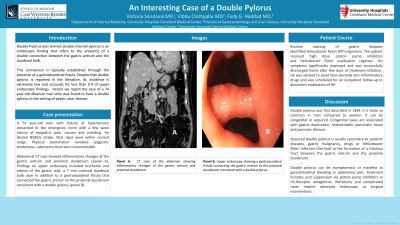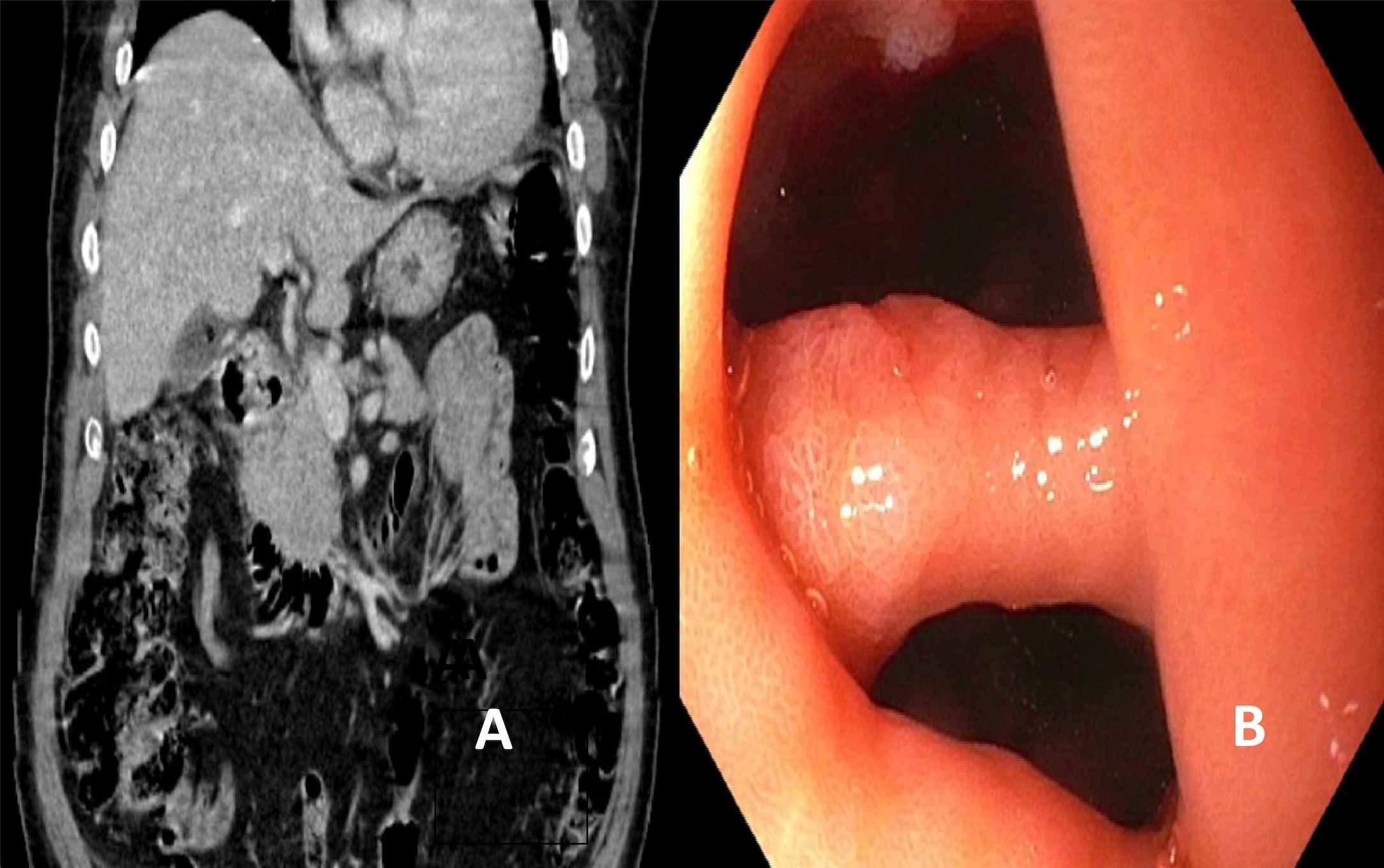Back


Poster Session B - Monday Morning
Category: Stomach
B0717 - An Interesting Case of a Double Pylorus
Monday, October 24, 2022
10:00 AM – 12:00 PM ET
Location: Crown Ballroom

Has Audio

Victoria Sandoval, MD
University Hospitals Cleveland Medical Center/ Case Western Reserve University
Cleveland, OH
Presenting Author(s)
Victoria Sandoval, MD1, Vibhu Chittajallu, MD1, Fady G. Haddad, MD2
1University Hospitals Cleveland Medical Center/ Case Western Reserve University, Cleveland, OH; 2University Hospitals Parma Medical Center, Parma, OH
Introduction: Double pylorus also termed double-channel pylorus is an endoscopic finding that refers to the presence of a double connection between the gastric antrum and the duodenal bulb. This connection is typically established through the presence of a gastroduodenal fistula. Despite that double pylorus is reported in the literature, its incidence is extremely low and accounts for less than 0.4% of upper endoscopic findings. Herein we report the case of 74 year-old Albanian man who was found to have a double pylorus in the setting of peptic ulcer disease.
Case Description/Methods: A 74 year-old man with history of hypertension presented to the emergency room with a few week history of epigastric pain, nausea and vomiting. He denied NSAIDs intake. Vital signs were within normal range. Physical examination revealed epigastric tenderness. Laboratory tests were unremarkable. Abdominal CT scan showed inflammatory changes of the gastric antrum and proximal duodenum (panel A). Findings on upper endoscopy included erythema and edema of the gastric wall, a 7 mm cratered duodenal bulb ulcer in addition to a gastroduodenal fistula that connected the gastric antrum to the proximal duodenum consistent with a double pylorus (panel B). Routine staining of gastric biopsies identified Helicobacter Pylori (HP) organisms. The patient received high dose proton pump inhibitors and Helicobacter Pylori eradication regimen. His symptoms significantly improved and was successfully discharged home after few days of treatment initiation. He was advised to avoid Non-steroidal anti-inflammatory drugs and was scheduled for an outpatient follow-up to document eradication of HP.
Discussion: Double pylorus was first described in 1969. It is twice as common in men compared to women. It can be congenital or acquired. Congenital cases are associated with gastric duplication, heterotrophic pancreatic tissue and pancreas divisum. Acquired double pylorus is usually secondary to systemic diseases, gastric malignancy, drugs or Helicobacter Pylori infection that lead to the formation of a fistulous tract between the gastric antrum and the proximal duodenum. Double pylorus can be asymptomatic or manifest as gastrointestinal bleeding or abdominal pain. Treatment includes acid suppression via proton pump inhibitors or H2-Receptor antagonists. Refractory and complicated cases require advanced endoscopic or surgical interventions.

Disclosures:
Victoria Sandoval, MD1, Vibhu Chittajallu, MD1, Fady G. Haddad, MD2. B0717 - An Interesting Case of a Double Pylorus, ACG 2022 Annual Scientific Meeting Abstracts. Charlotte, NC: American College of Gastroenterology.
1University Hospitals Cleveland Medical Center/ Case Western Reserve University, Cleveland, OH; 2University Hospitals Parma Medical Center, Parma, OH
Introduction: Double pylorus also termed double-channel pylorus is an endoscopic finding that refers to the presence of a double connection between the gastric antrum and the duodenal bulb. This connection is typically established through the presence of a gastroduodenal fistula. Despite that double pylorus is reported in the literature, its incidence is extremely low and accounts for less than 0.4% of upper endoscopic findings. Herein we report the case of 74 year-old Albanian man who was found to have a double pylorus in the setting of peptic ulcer disease.
Case Description/Methods: A 74 year-old man with history of hypertension presented to the emergency room with a few week history of epigastric pain, nausea and vomiting. He denied NSAIDs intake. Vital signs were within normal range. Physical examination revealed epigastric tenderness. Laboratory tests were unremarkable. Abdominal CT scan showed inflammatory changes of the gastric antrum and proximal duodenum (panel A). Findings on upper endoscopy included erythema and edema of the gastric wall, a 7 mm cratered duodenal bulb ulcer in addition to a gastroduodenal fistula that connected the gastric antrum to the proximal duodenum consistent with a double pylorus (panel B). Routine staining of gastric biopsies identified Helicobacter Pylori (HP) organisms. The patient received high dose proton pump inhibitors and Helicobacter Pylori eradication regimen. His symptoms significantly improved and was successfully discharged home after few days of treatment initiation. He was advised to avoid Non-steroidal anti-inflammatory drugs and was scheduled for an outpatient follow-up to document eradication of HP.
Discussion: Double pylorus was first described in 1969. It is twice as common in men compared to women. It can be congenital or acquired. Congenital cases are associated with gastric duplication, heterotrophic pancreatic tissue and pancreas divisum. Acquired double pylorus is usually secondary to systemic diseases, gastric malignancy, drugs or Helicobacter Pylori infection that lead to the formation of a fistulous tract between the gastric antrum and the proximal duodenum. Double pylorus can be asymptomatic or manifest as gastrointestinal bleeding or abdominal pain. Treatment includes acid suppression via proton pump inhibitors or H2-Receptor antagonists. Refractory and complicated cases require advanced endoscopic or surgical interventions.

Figure: Panel A: CT scan of the abdomen showing inflammatory changes of the gastric antrum and proximal duodenum; Panel B: Upper endoscopy showing a gastroduodenal fistula connecting the gastric antrum to the proximal duodenum consistent with a double pylorus
Disclosures:
Victoria Sandoval indicated no relevant financial relationships.
Vibhu Chittajallu indicated no relevant financial relationships.
Fady Haddad indicated no relevant financial relationships.
Victoria Sandoval, MD1, Vibhu Chittajallu, MD1, Fady G. Haddad, MD2. B0717 - An Interesting Case of a Double Pylorus, ACG 2022 Annual Scientific Meeting Abstracts. Charlotte, NC: American College of Gastroenterology.
